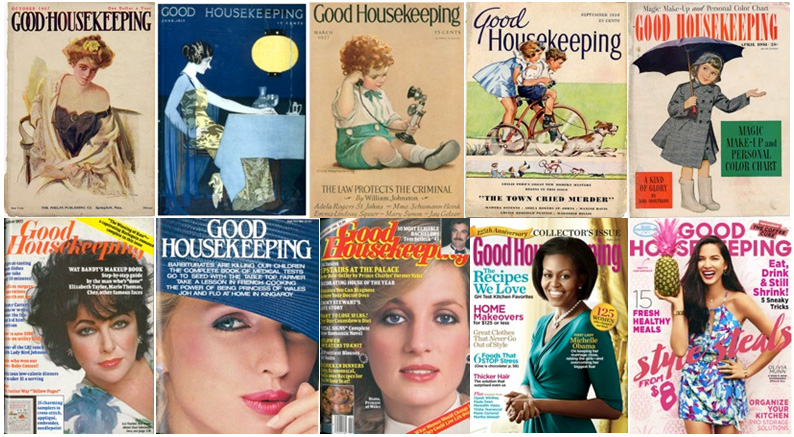Yes, old Good Housekeeping magazines can be worth something. Their value depends on various factors like rarity, condition, and demand.
Collectors and vintage lovers often search for old magazines. Good Housekeeping, with its rich history, is no exception. These magazines offer a glimpse into the past, showcasing trends and lifestyles of different eras. Some collectors prize them for their nostalgic value, while others seek specific issues for their unique content.
Whether you have a stack in your attic or stumbled upon some at a garage sale, it’s worth understanding what makes these magazines valuable. This knowledge can help you decide if selling, keeping, or even starting a collection is worthwhile. Ready to dive deeper into their potential value? Let’s explore.

Value Of Vintage Magazines
Are old Good Housekeeping magazines worth anything? Many people find old magazines in their homes and wonder if they hold any value. The value of vintage magazines can vary greatly. Collectors often seek out these publications for their nostalgic value, historical content, and unique illustrations. In this post, we will explore the market trends and collector interest surrounding vintage Good Housekeeping magazines.
Market Trends
The market for vintage magazines has seen a steady rise over recent years. This trend is driven by the increasing interest in nostalgic items. People love to revisit the past, and old magazines provide a snapshot of a different era. Here are some key market trends to consider:
- Increased Demand: Collectors and enthusiasts are always on the lookout for rare and well-preserved issues.
- Online Marketplaces: Websites like eBay and Etsy have made it easier to buy and sell vintage magazines.
- Condition Matters: Magazines in mint condition fetch higher prices compared to those with torn pages or stains.
- Special Editions: Issues featuring significant events or famous personalities are particularly valuable.
A quick search on popular online marketplaces reveals that prices can range from a few dollars to several hundred dollars, depending on the issue’s rarity and condition. For example, a 1950s Good Housekeeping magazine in excellent condition might sell for around $20 to $50. In contrast, a rare issue from the 1920s could fetch over $100.
| Issue Date | Condition | Estimated Value |
| 1950s | Excellent | $20 – $50 |
| 1920s | Good | $100+ |
Collector Interest
Collector interest in vintage Good Housekeeping magazines is driven by various factors. Nostalgia plays a significant role. Many collectors seek to recapture the essence of a bygone era. Here are a few reasons why collectors are interested in these magazines:
- Nostalgic Value: People enjoy reminiscing about past decades through advertisements, articles, and illustrations.
- Historical Insights: These magazines offer a glimpse into the social and cultural norms of the time.
- Art and Design: Vintage magazines often feature unique artwork and design styles that are no longer common today.
- Celebrity Features: Issues with covers or articles about famous personalities are highly sought after.
For collectors, finding a rare issue is akin to discovering a treasure. They often go to great lengths to complete their collections, attending flea markets, estate sales, and auctions. Some even join collector clubs or online forums to connect with fellow enthusiasts. The thrill of the hunt and the joy of discovering a rare piece make collecting vintage magazines a rewarding hobby.

To Get The Best Housekeeping service – Click Here
Factors Affecting Worth
Old Good Housekeeping magazines can be valuable. The worth of these magazines depends on many factors. Understanding these factors can help you determine if your collection has any significant value.
Condition And Quality
The condition of a magazine greatly impacts its worth. Collectors look for magazines that are well-preserved. Here are some key points to consider:
- Cover Quality: Is the cover intact? Are there any tears, stains, or creases?
- Pages: Are the pages yellowed or brittle? Are there any missing or damaged pages?
- Binding: Is the binding still strong? Does the magazine open smoothly without pages falling out?
Magazines in mint condition fetch higher prices. Those with damages or wear might still be valuable, but less so. Grading the quality of the magazine can help.
| Condition | Description | Value |
| Mint | Perfect condition, no flaws | High |
| Good | Minor wear and tear, overall good | Moderate |
| Poor | Significant damage, but readable | Low |
Proper storage can maintain the quality. Keep magazines in a cool, dry place. Use protective covers to prevent dust and damage.
Rarity And Demand
Rarity is another crucial factor. Some issues are harder to find than others. Limited editions or first issues are often more valuable. Consider these points:
- Print Run: How many copies were originally printed?
- Special Editions: Are there any special features, such as holiday issues or celebrity covers?
- Age: Older magazines are generally rarer and more valuable.
Demand also affects value. Popular issues with significant cultural or historical relevance are sought after. For instance:
- Issues featuring major events or famous personalities.
- Magazines with iconic advertisements or articles.
- Special editions that mark anniversaries or milestones.
High demand, coupled with low supply, increases value. Researching current market trends and recent sales can help gauge demand.
In summary, both condition and rarity play major roles. A well-preserved, rare magazine can be quite valuable. Consider these factors when evaluating your Good Housekeeping collection.
Popular Issues
Many people wonder if old Good Housekeeping magazines hold any value. Popular issues of these magazines can indeed be worth something. Collectors seek out certain editions for their unique content and memorable covers. Let’s explore some of the popular issues that might interest you.
Iconic Covers
Some Good Housekeeping magazines have iconic covers that make them more valuable. Collectors often seek issues with covers featuring famous personalities or groundbreaking designs.
- Marilyn Monroe (May 1953): This issue is highly sought after due to its glamorous cover featuring the iconic actress.
- Audrey Hepburn (July 1961): Audrey’s timeless elegance makes this issue a collector’s favorite.
- Jacqueline Kennedy (December 1962): Featuring the First Lady, this issue is a piece of history.
Beyond celebrity covers, certain editions with special themes or unique artwork can also be valuable. For example:
| Issue | Reason for Popularity |
| December 1922 | Classic holiday cover with Norman Rockwell art |
| June 1945 | WWII Victory Edition |
| April 1976 | Bicentennial Celebration |
These covers capture moments in time, making them appealing to collectors and history enthusiasts.
Notable Features
Besides their covers, certain Good Housekeeping issues are valuable for their notable features. These features include special articles, groundbreaking recipes, and unique advertisements that reflect the era.
- Health and Wellness Tips: Articles from the early 1900s provide a glimpse into past health trends.
- Home Improvement Guides: Mid-century issues offer DIY projects that are still relevant today.
- Vintage Recipes: Classic recipes from the 1930s and 1940s are treasured by vintage cooking enthusiasts.
Collectors also look for issues with:
- Exclusive Interviews: Conversations with celebrities or influential figures.
- First Appearances: Debut articles from renowned writers or chefs.
- Special Editions: Issues dedicated to significant events or anniversaries.
For instance, the May 1945 issue, celebrating the end of WWII, features articles and advertisements that capture the post-war spirit. Meanwhile, the January 1960 issue, looking into future home trends, offers fascinating insights into mid-century modern design.
These elements make certain Good Housekeeping magazines not just collectibles, but also windows into the past, cherished by historians and enthusiasts alike.
Where To Buy And Sell
Collecting old Good Housekeeping magazines can be both a nostalgic and profitable hobby. These vintage issues are often sought after for their historical value, retro advertisements, and unique articles. If you’re wondering where to buy and sell old Good Housekeeping magazines, there are various platforms and venues to explore. Below, we will discuss some popular options for trading these cherished publications.
To Get The Best Housekeeping service – Click Here
Online Marketplaces
Online marketplaces are a convenient option for buying and selling old Good Housekeeping magazines. These platforms reach a wide audience, increasing the chances of finding interested buyers or sellers. Some popular online marketplaces include:
- eBay: eBay is a well-known platform for vintage items. You can find a wide range of Good Housekeeping magazines here. Sellers often list magazines by decade or special issues.
- Etsy: Etsy is another excellent option for vintage and collectible items. Many sellers on Etsy specialize in vintage publications, making it easier to find specific editions.
- Amazon: While Amazon is primarily known for new items, it also has a marketplace for used and collectible goods. You may find older issues of Good Housekeeping listed by third-party sellers.
- Facebook Marketplace: Facebook Marketplace allows you to buy and sell items locally. This can be a good option if you prefer to avoid shipping costs.
When using online marketplaces, make sure to:
- Check the seller’s ratings and reviews.
- Review the magazine’s condition in photos.
- Compare prices across multiple listings.
- Read the item description carefully for any defects or missing pages.
Local Auctions
Local auctions are another great place to buy and sell old Good Housekeeping magazines. Auctions can sometimes offer rare finds at competitive prices. Consider these options:
- Estate Sales: Estate sales often feature a variety of vintage items, including magazines. Check local listings or online directories like EstateSales.net to find sales in your area.
- Antique Shops: Many antique shops hold periodic auctions. Some shops might even specialize in vintage publications.
- Flea Markets: Flea markets are a treasure trove for vintage items. You may find individual sellers with collections of old magazines.
- Library Sales: Some libraries hold annual sales of donated or deaccessioned items. These sales can include old magazines at very low prices.
When attending local auctions, remember to:
- Arrive early to inspect the items.
- Set a budget to avoid overspending.
- Bring cash, as some sellers may not accept cards.
- Ask questions about the item’s history and condition.
Both online marketplaces and local auctions offer unique advantages. Choose the option that best suits your preferences and start building your collection of Good Housekeeping magazines today!
Appraisal Techniques
Are old Good Housekeeping magazines worth anything? If you are curious about the value of these vintage treasures, appraisal techniques can help you determine their worth. Understanding how to appraise these magazines can be an enjoyable and insightful experience. This section will guide you through professional and self-appraisal methods to assess your collection accurately.
Professional Appraisers
Consulting a professional appraiser is a reliable way to determine the value of your old Good Housekeeping magazines. These experts have the knowledge and experience to provide an accurate assessment. Here are some steps to consider:
- Research: Find an appraiser who specializes in vintage magazines or collectibles. Check their credentials and reviews.
- Consultation: Schedule an appointment with the appraiser. Bring your magazines and any relevant information, such as publication dates and condition.
- Evaluation: The appraiser will inspect your magazines for factors such as rarity, demand, and physical condition. They will also consider historical significance and market trends.
- Report: After the evaluation, the appraiser will provide a detailed report. This report includes the estimated value and justification for their assessment.
Here’s a table to help you understand the common criteria used by professional appraisers:
| Criteria | Description |
| Rarity | How rare or uncommon the magazine issue is. |
| Condition | Physical state, such as wear, tears, and discoloration. |
| Demand | Current market interest and buyer demand. |
| Historical Significance | Importance of the issue in historical context. |
Professional appraisers provide a thorough and accurate assessment, making them a valuable resource for serious collectors.
Self-appraisal Tips
If you prefer to appraise your magazines yourself, there are several tips to guide you. While it might not be as precise as a professional appraisal, self-appraisal can still offer valuable insights.
Here are some self-appraisal tips:
- Research Online: Look for similar issues on auction sites like eBay. Compare prices and conditions.
- Check Condition: Inspect your magazines carefully. Look for any damage, such as tears, stains, or missing pages.
- Identify Rare Issues: Some issues are more valuable than others. Special editions or those featuring famous covers are often worth more.
- Historical Context: Understand the historical context of the issue. Magazines covering significant events may have higher value.
- Consult Price Guides: Use price guides and reference books to get an idea of the market value. Libraries and online resources can be helpful.
Here’s a simple checklist for self-appraisal:
| Step | Action |
| 1 | Research similar issues online |
| 2 | Inspect magazine condition |
| 3 | Identify rare or special editions |
| 4 | Understand historical significance |
| 5 | Consult price guides |
Self-appraisal can be a fun and educational process, helping you appreciate your collection’s value. Whether you choose professional appraisal or self-appraisal, understanding these techniques ensures you get the most out of your vintage Good Housekeeping magazines.
Restoration And Preservation
Old Good Housekeeping magazines can be valuable treasures. Restoration and preservation are key to maintaining their worth. Proper care can keep these vintage magazines in great condition. Below, we discuss cleaning methods and storage solutions to help preserve these collectibles.
Cleaning Methods
Cleaning old magazines requires gentle techniques. Dust and dirt can damage the delicate paper. Here are some methods to clean them effectively:
- Dusting: Use a soft brush to remove surface dust. A makeup brush or a paintbrush works well.
- Dry Cleaning Sponge: This special sponge can lift dirt without using water. Rub it gently over the magazine surface.
- Eraser: A white vinyl eraser can remove small stains. Rub it lightly to avoid tearing the paper.
For deeper stains, professional cleaning might be necessary. Avoid using water or liquid cleaners. These can cause ink to run or pages to warp. Always handle the magazine with clean, dry hands to prevent oil transfer from your skin.
Storage Solutions
Proper storage is essential to preserve old magazines. Follow these tips to keep your magazines in top condition:
- Climate Control: Store magazines in a cool, dry place. Avoid areas with high humidity or temperature fluctuations.
- Protective Covers: Use acid-free plastic covers or sleeves. These protect against dust and light exposure.
- Archival Boxes: Store magazines in archival-quality boxes. These boxes are acid-free and provide excellent protection.
- Vertical Storage: Store magazines upright, like books, to prevent bending or warping.
Consider creating an inventory list. This helps keep track of your collection. Use descriptive labels on storage boxes for easy identification. Avoid stacking magazines directly on top of each other. This can cause damage to the covers and spines.
By following these cleaning and storage tips, you can keep your old Good Housekeeping magazines in excellent condition. Proper care ensures their value for years to come.
Community Of Collectors
Are old Good Housekeeping magazines worth anything? The short answer is yes. For many, these vintage magazines hold sentimental value. They offer a glimpse into the past, showcasing trends, recipes, and advice from yesteryears. A community of collectors has formed around these treasures, sharing their finds and insights with others who cherish these pieces of history.
To Get The Best Housekeeping service – Click Here
Online Forums
The internet has made it easier than ever for collectors to connect. Online forums are a hub for enthusiasts to discuss their collections, share tips, and even buy or sell old magazines. These forums are filled with passionate individuals who share a love for vintage Good Housekeeping issues.
In these forums, you can find:
- Advice on how to preserve old magazines.
- Guides on determining the value of specific issues.
- Stories and memories associated with various editions.
Some popular online forums for magazine collectors include:
| Forum Name | Description |
| Antique Magazine Collectors | A place for discussing all types of vintage magazines. |
| Good Housekeeping Enthusiasts | Focused specifically on Good Housekeeping issues. |
Joining these forums can provide valuable insights and connect you with fellow collectors who share your passion.
Local Clubs
Local clubs offer a more personal way to connect with other collectors. These clubs often host meetings where members can bring their magazines, share stories, and even trade or sell issues. Being part of a local club allows you to see magazines in person, which is something online forums can’t offer.
Benefits of joining a local club include:
- Networking with other collectors.
- Attending events and swap meets.
- Learning from experienced collectors.
Here are some examples of what local clubs might offer:
| Club Activity | Description |
| Monthly Meetings | Discuss recent finds and share tips. |
| Swap Meets | Trade or sell magazines with other members. |
Being part of a local club can make your collecting experience more enjoyable and rewarding. It’s a great way to meet like-minded individuals who appreciate the history and value of old Good Housekeeping magazines.

Fakes And Reproductions
Collecting old Good Housekeeping magazines can be a delightful hobby. These vintage publications offer a glimpse into history, culture, and trends from decades past. But the market is also flooded with fakes and reproductions. Understanding the value of these magazines means knowing how to spot authentic copies and avoid scams.
Identifying Authenticity
Determining if a Good Housekeeping magazine is authentic can be tricky. Here are key points to consider:
- Publication Date: Check the date on the cover. Authentic vintage magazines will have the original publication date clearly printed.
- Paper Quality: Older magazines often have yellowed pages due to aging. Reproductions might use new, whiter paper.
- Print Quality: Look for inconsistencies in print. Authentic copies will have sharper, clearer images and text.
- Binding: Authentic magazines from earlier decades will usually show wear on the spine and edges.
- Advertisements: Vintage ads are a good indicator of authenticity. Compare ads with known originals from the same era.
Here’s a comparison table to help you identify authentic magazines:
| Feature | Authentic | Fake/Reproduction |
| Publication Date | Clearly printed, matches era | May be missing or incorrect |
| Paper Quality | Yellowed, aged paper | Bright, new paper |
| Print Quality | Sharp, clear images | Blurry, inconsistent print |
| Binding | Worn edges, spine wear | New, pristine condition |
| Advertisements | Matches known originals | May have modern ads |
Common Scams
The world of vintage magazines is not free from scammers. Here are some common scams to watch out for:
- Reprinted Covers: Scammers may use original covers with new content inside. Always check the entire magazine.
- Photocopies: Some sellers create high-quality photocopies and try to pass them off as originals. Check the paper quality and print consistency.
- Altered Dates: Scammers may alter publication dates to make magazines seem older. Verify dates with known issues from the same period.
- Fake Signatures: Some magazines are sold with fake autographs. Research the authenticity of any signed copies.
To protect yourself, follow these tips:
- Research the seller. Check reviews and ratings.
- Ask for detailed photos of the magazine.
- Compare with known authentic copies.
- Be wary of deals that seem too good to be true.
Staying informed and vigilant is the best way to ensure your collection remains authentic and valuable.
Legacy And Nostalgia
Are old Good Housekeeping magazines worth anything? This question often arises among collectors and those who cherish nostalgia. These magazines hold a special place in history, offering a glimpse into the past. The legacy they carry is rich and meaningful, blending cultural impact with personal stories that resonate with many.
To Get The Best Housekeeping service – Click Here
Cultural Impact
Good Housekeeping magazines have been a staple in many households for decades. They reflect societal changes and trends over time. The articles, ads, and images provide insights into the lives of past generations.
- Historical Value: Old issues capture the essence of different eras. They showcase fashion, home decor, and social norms.
- Educational Resource: Schools and researchers use these magazines to study history and culture.
- Pop Culture: Many celebrities and public figures have graced the covers, adding to their collectible value.
For instance, a 1950s Good Housekeeping magazine might feature:
| Category | Content |
| Fashion | Vintage dresses, hats, and accessories |
| Recipes | Classic dishes and cooking tips |
| Advertisements | Retro ads for household products |
These elements not only entertain but also educate. They help us understand how society has evolved. Collectors often seek specific issues that highlight significant events or trends.
Personal Stories
Many people have personal connections to Good Housekeeping magazines. They remember reading them with family or finding inspiration in their pages.
Consider these personal stories:
- Family Heirlooms: Some families pass down collections of these magazines through generations. They hold sentimental value.
- Memory Lane: Individuals often recall specific issues that marked special moments in their lives.
- Creative Inspiration: Many have used the articles and DIY projects to create cherished home decor and gifts.
For example, Jane, a reader, shared:
“My grandmother used to keep stacks of Good Housekeeping in her living room. I spent hours flipping through them as a child. The recipes became a tradition for our family gatherings.”
These personal stories highlight the emotional connection people have with these magazines. They are more than just printed pages. They are memories, inspirations, and pieces of history woven into the fabric of many lives.

Frequently Asked Questions
Are Old Good Housekeeping Magazines Valuable?
Yes, they can be. Their value depends on age, condition, and rarity.
How Do I Determine The Value Of Old Magazines?
Check online marketplaces and auction sites. Look for similar items to compare prices.
Where Can I Sell Old Good Housekeeping Magazines?
You can sell them on eBay, Etsy, or specialized vintage shops.
What Makes A Good Housekeeping Magazine Collectible?
Rarity, condition, and historical significance. Special issues or famous cover stars are more valuable.
Conclusion
Old Good Housekeeping magazines can hold value for various reasons. Collectors often seek rare issues. Others enjoy the nostalgic content. You might even find historical information inside. Check the condition and rarity of your magazines. Research online for their worth.
Visit local antique shops too. Keep an eye on auction sites. You never know their true value. Happy treasure hunting!
